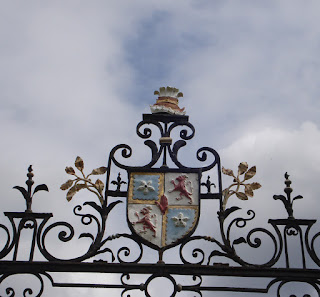 Seaton Delaval Hall ~ the finest work of the English Baroque and one of the most important historic houses in Britain. The Grade I listed building was built between 1718 and 1731 by Sir John Vanbrugh, architect of Blenheim Palace and Castle Howard. The recent National Trust campaign allowed them to take over the house, its gardens and 400 acres of surrounding land from Lord Hastings, who died, aged 95, in 2007.
Seaton Delaval Hall ~ the finest work of the English Baroque and one of the most important historic houses in Britain. The Grade I listed building was built between 1718 and 1731 by Sir John Vanbrugh, architect of Blenheim Palace and Castle Howard. The recent National Trust campaign allowed them to take over the house, its gardens and 400 acres of surrounding land from Lord Hastings, who died, aged 95, in 2007.This is the third weekend it has been open to the public, and we enjoyed our visit. The gardens are particularly lovely and we promised ourselves we’d go back again in a week or two when more plants will be in bloom.
The house is a surprise. From the outside it looks wonderful, but inside it is an empty shell. A fire in 1822 burned out all the floors and walls between the ground floor and the roof. All that  remains is the brickwork skeleton and stone staircases. Fireplaces are dotted at various heights about the walls. The earthen floored cellars stretch beneath the house, and the hastily placed legend tells that men and women servants ate their meals in two separate rooms down here. Hard to believe. There are few windows, and it isn't as if the hall lacks for space. The east wing is given over to stone stables, still bearing the names of the horses who lived there, and the West wing, we are told, is where the servants were quartered.
remains is the brickwork skeleton and stone staircases. Fireplaces are dotted at various heights about the walls. The earthen floored cellars stretch beneath the house, and the hastily placed legend tells that men and women servants ate their meals in two separate rooms down here. Hard to believe. There are few windows, and it isn't as if the hall lacks for space. The east wing is given over to stone stables, still bearing the names of the horses who lived there, and the West wing, we are told, is where the servants were quartered.
 remains is the brickwork skeleton and stone staircases. Fireplaces are dotted at various heights about the walls. The earthen floored cellars stretch beneath the house, and the hastily placed legend tells that men and women servants ate their meals in two separate rooms down here. Hard to believe. There are few windows, and it isn't as if the hall lacks for space. The east wing is given over to stone stables, still bearing the names of the horses who lived there, and the West wing, we are told, is where the servants were quartered.
remains is the brickwork skeleton and stone staircases. Fireplaces are dotted at various heights about the walls. The earthen floored cellars stretch beneath the house, and the hastily placed legend tells that men and women servants ate their meals in two separate rooms down here. Hard to believe. There are few windows, and it isn't as if the hall lacks for space. The east wing is given over to stone stables, still bearing the names of the horses who lived there, and the West wing, we are told, is where the servants were quartered. The drinking troughs in the stables are lead lined, so perhaps the horses were slowly and unknowingly poisoned. There is a huge ornamental lead flower pot dated 1662 in the garden, and an orangery with dancing cherubs decorating the roof outside.
Lord and Lady Hastings lived in the West wing since 1990, where they made a comfortable family home because the central house had long been let go. There are some lovely paintings in their quarters, and carved oak chairs. The whole place is very much a work in progress, and fascinating because of that. The tiny church among the bluebells dates from 1102 AD - yes, from Norman times. It is far, far older than the house.
There is a tea room in the east wing, but it is tiny and when we wnt it was crammed with people and hot as a Turkish steam bath. We didn't stay. Maybe plan to take sandwiches and eat in the car!
Read more courtesy of the Daily Mail. As the long article says, the place is an unexpected treasure in a very industrial corner of Northumberland. I'd never been before, yet it is barely twenty miles from me. I found an extra dimension to the visit because one of my fellow critiquers writes of the period this house was built and first lived in. I looked at the paintings, the great seals, the documents and imagined her characters seated on the carved oak chairs. I'm already looking forward to going back again.


1 comment:
Finally had a moment of time to browse through your latest blog comments again - and found this one. Made me curious enough to research it and look at the virtual tour of the National Trust website. Fascinating, esp. the interior of the main building and the lovely stables. I'm glad they're preserving this lovely piece of architecture!
Post a Comment